
Whichever character the first player picks becomes unavailable to the second player and vice versa.
Review by Jay Wilson With very few exceptions, I’m opposed to stories in video games. Unless you’re a writer or an orator, stories are a passive medium. You sit and listen, or you read a book. Video games are an active medium. They require interaction. And while a handful of video games have successfully found a happy hybrid of passive storytelling with active gameplay, most of the time it’s interrupting the playing experience—the very definition of a game. However, I am not opposed to video games having a premise. A premise is the skeletal structure of a story—the suggestion of a story—without all the passive watching and reading that shuts down the gaming. And Sega’s 1989 arcade classic, Golden Axe, beautifully demonstrates what a premise can do. It doesn’t even tell you your character’s name when you pick them. I used Tyris Flare exclusively for decades without knowing her name. It is in the game. It’s on the attract screen. It also informs me that she’s “the Amazon” and that her parents were killed by Death Adder. But you know what? I never watched the attract screen. I was too busy beating the crap out of evil thugs and even more evil tyrants. After you pick your character, Golden Axe starts off with your chosen hero walking along the path when up ahead a cripple on crutches gets attacked. Boom. Motivation. Protect the defenseless! And if you want to read it, the game even has (skippable) dialog. With his dying words, Alex (the cripple), informs you the King and his daughter have been kidnapped by Death Adder and asks you to “revenge them for me.” That, my friends, is a premise. Who is Alex? Who is this royalty? What are their names? And what land do they rule? Who are these heroes and where did they come from? 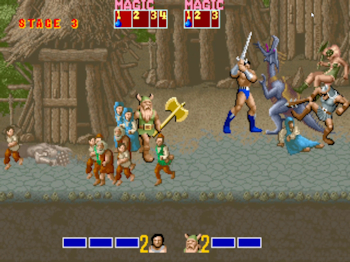
Golden Axe creates a sense of urgency and purpose while playing with fleeing villagers and bad guys stomping on innocent people’s faces.
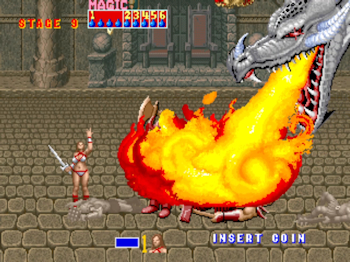
You don’t have to fill up your magic meter to cast a spell, but it will be that much more powerful if you do.
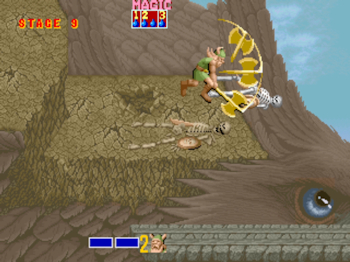
Notice Gilius is fighting on the back of a giant eagle. Most of the previous stage is spent flying above unseen armies to Death Adder’s fortress.

Pressing Attack+Jump simultaneously will trigger a reverse attack; however, they’re very slow, and there’s better options for dealing with being surrounded.

Later bosses will attack the instant they’re in range and on the same horizontal plane, giving them first strike against 90% of what you do. You have to trick the AI into walking into your attack.
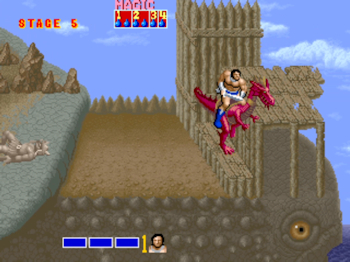
Don’t blink or you’ll miss the one bit of platforming when you leave Turtle Village; you’ll also probably miss the jump and die a stupid death.
Who cares? Golden Axe’s plot, characters, and setting operate on an almost subliminal level. Take for example the bonus stages: after each mission, your character is asleep by a campfire on the final screen of the previous encounter when little elven thieves show up in the night and scare off any mounts you might have acquired. They’ll also steal your potions for casting magic. Your character will wake up, and you can kick the thieves around to get back your potions, pick up additional potions, and get back lost health. This serves an obvious in-game benefit while simultaneously explaining why you can’t keep your overpowered mount; however, at the same time it creates a greater connection between us, the players, and these characters because it helps put us in this journey together. They fight while we frantically mash buttons and they rest while we take a breather. And logical pauses are welcomed in games. Like good fiction, video games are best when they follow the classic narrative arc of escalating conflict that peaks at the climax and calms down with the resolution before ramping up again for the next conflict. Each level provides escalating conflict with wave after wave of henchmen, it peaks at a boss fight, and the bonus stages provide the calm that follows. And right after the bonus stage, Golden Axe shows a purely aesthetics map accompanied by text for what might as well be internal dialog—two or three sentences usually describing where we came from and where we’re going—as if the next morning the heroes wake up and plan their course of action for that day. Now I can hit a button, skip the map, and jump right into another wave of Death Adder’s unholy minions, and I do. But the weird thing is it’s so brief and simple, you only have to read it once because ever after your mind will fill in the blank. That’s one of the things the human brain does really well; it doesn’t have to process every single itty-bitty stimulant. It can ignore tons of insignificant details and even significant details because it’s dealt with it before. You see a brick wall, and you don’t have to count the bricks. Golden Axe’s “We came from point A; now on to point B” internal monologues tell you there’s a brick wall. A cutscene with action, dialog, and complex cinematics is taking stock of the bricks. One will stay with you with every single play through because your mind can instantly and effortlessly put it there. Picture a brick wall. Now picture a pile of exactly 35 bricks—not 34 and not 36—exactly 35 arranged symmetrically with half laying lengthwise, a quarter laying height-wise, and a quarter laying depth-wise. Which one can you imagine? And here’s the cool part: your mind will actually flesh out Golden Axe’s missing details such as hearing your chosen hero reciting the narration in their own voice, and since it’s your imagination at work, you’re far less likely to be appalled by the voice actor the developers picked for Ax Battler. That is why suggestion is much more powerful than full blown exposition. Another wonderful example: the main levels take place during the day, however, going into said level’s final encounter the palette will change to warmer hues, indicating dusk. It doesn’t interrupt the game. It doesn’t distract from the game. It doesn’t even draw attention to itself. It just happens while you’re playing. But because it happens and because the campfire bonus stages take place on the very same screen with, now, a cool night palette, it conveys the passage of time. And that one suggestion builds a feeling of verisimilitude, a believable setting with day and night cycles which makes the journey feel more like an actual fantasy adventure because it takes several days to travel to Death Adder’s fortress, riding on giant beasts of mythical proportions, battling wave after wave of enemies with larger than life bosses, fending off thieves in the night, and preparing for the road ahead come morning. All that delivered in a humble twenty minutes. Gameplay wise, in the holy trinity of 1989 arcade beat ‘em ups (Golden Axe along with Final Fight and Teenage Mutant Ninja Turtles), Sega’s game is the only one that allows running and the only one that has three buttons (standard jump and attack plus magic but only if you have meter for it) which goes a long way in setting it apart. Enemies will sprint to the other side of the screen to flank you which is extremely bad because out of the three, Golden Axe is by far the worst in terms of dealing with being surrounded, but that in no way makes it the lesser of the group. It makes it the most strategic because it puts that much more emphasis on knockdowns, positioning, and makes the limited-use full screen magic attacks that much more valuable. As mentioned earlier, Golden Axe gives you the ability to run which doesn’t so much serve as an escape, but rather as a preventative measure. You see, attacking while running yields a shoulder ram with Gilius and Ax and a jump kick with Tyris. If you miss, you recover immediately and can avoid incoming attacks; however, if it hits, it pushes your victim back about a half screen’s distance and knocks them down, giving you space while buying you time. This lets you control the battlefield which in turn lets you engage enemies on your terms. And you can do a lot of damage voluntarily letting them flank you and running back and forth, knocking them down one after the other so neither is standing at the same time because if they’re on their back, they’re not attacking you. It’s actually the safest most effective tactic. You can even get it to work on bosses with a little vertical positioning worked into the equation. You know what else Golden Axe gives you to deal with the nightmare that is being surrounded? Mounts. I think the whole reason why you’re not a godlike super hero is to make the mounts that much more badass. Even the weird tail-wagging chicken leg thing makes hitting Death Adder’s minions so much easier, extending your range and killing early enemies with a single hit. The blue dragon who breathes streams of fire at the ground does less damage (or maybe enemies just have more life in later stages), but that’s okay because he still lets you hit bosses in safety, and if he doesn’t one-shot enemies that just means you get to roast their ankles again and again until they die. But the best by a landslide, is the red dragon who shoots a small ball of fire all the way across the screen. Protect this beast with your life because if you lose this thing, you will die. A lot. And you will miss out on the endless, euphoric joys of killing the game’s entire cast of exclusively melee enemies racing towards you in complete and utter single-file futility. This is probably the only arcade game that allows you to absolutely annihilate its bosses with utter impunity if you can just hold on to one of these magical beasts. 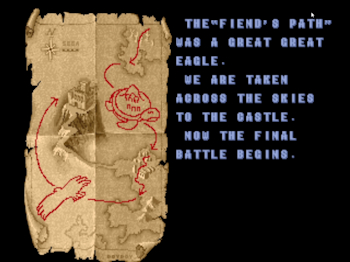
The route the heroes take gets drawn in gradually as you progress through the game. It’s simple, elegant, skippable, and it adds to the feeling that these heroes are on a journey.

These little guys will steal potions if you have any left over. You can usually get them back plus more, but I think it’s better to use them at the boss fight so you have nothing to lose here except your mount.
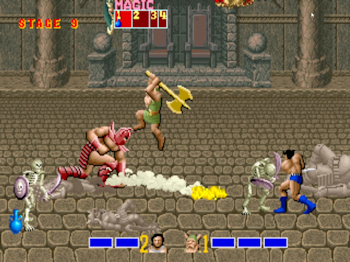
The arcade ends here with Death Adder, but the home ports continue on for one more level against a Death Adder palette swap with some truly evil tricks up his sleeve.
If you wanted to level a criticism at Golden Axe, you could say that you cannot get down off a mount short of being hit, so theoretically if you’re riding one creature and you want to upgrade to a more powerful creature, you have to let an enemy hit you off your current ride. But to give you an idea of how rare that situation is, it took me over twenty years to notice, and the only reason I did notice is because recently I decided I would try to play through using just my sword. No magic. No mounts. Nothing. And I happened to move too close to the chicken-leg thing, got up on it, and I could not get off. The auto-climb on mechanic has also gotten me killed, but again, that’s an extreme rarity. Once, and only once, I was knocked off my dragon right at the screen’s edge so Tyris didn’t have room to fall backwards. She fell on top of her ride which lead to the helpless cycle where as soon as Tyris would stand up she would automatically get back on, but before I could regain control the enemies would knock her off again. I only had to take two steps, but I couldn’t. She was trapped in an eternal loop where the only end was death. You could also say Golden Axe has flaky combo enders, but I take that more as a challenge than a flaw. After chaining together a couple of successful attacks, your enemy will go down on one knee. From here you can throw, thrust, or bash their head in with your pommel a few times before kicking them away, and all three are useful in different situations; however, your distance from the enemy dictates which ender you get, making it harder to get the one you want. The problem is the window for each is only a few pixels wide, and later enemies are so fast on the attack that you have to take your shots whenever you can, but at the same time you want to make sure those attacks land because missing means they’ll have time to close in and dispatch you quickly. I dunno how many times I attacked a fraction of a second too soon only to eat a mace that looks like a tree branch. Adding to the challenge, your character attacks so slowly that you have to hit the button while the enemies are just out of range, anticipating that they’ll move within range for that first hit because, again, they attack five times faster than you in later levels. For me personally, though, my only real complaint is that saving up nine potions for Tyris’ awe-inspiring dragon summon isn’t worth it. Sure, it looks wicked as hell, but most of the time you’ll reach the magic nine at the bonus stage or in the middle of a level that doesn’t have a boss fight. And since you went through the trouble of saving up all nine, you want to use it where you’ll do the most damage, so you end up waiting and picking up half a dozen more potions in the next level that won’t do any good because you can’t carry any in reserve meanwhile Tyris is taking unnecessary damage and dying when she should be casting and killing. This is what really makes Gilius the best. Yes, his axe has a little more range and he deals a little more damage, but people make that out to be a lot more than it actually is. Because Gilius’ magic meter is so short 1.) you’re more willing to use it at any time because you won’t feel like you’re wasting it 2.) you can fill it up again before the next boss and 3.) you’re doing more damage globally because you’re not wasting potions by picking them up while maxed out. So, it’s not that Gilius is leaps and bounds better than Tyris, it’s that Tyris’ magic meter manipulates you into using it less effectively. How about that? An 80s arcade beat ‘em up playing psychological mind games with its players to get them to play less efficiently, die more, and pump more quarters into it. And they say this genre is mindless and dumb ... | ||||||||||||||||||||
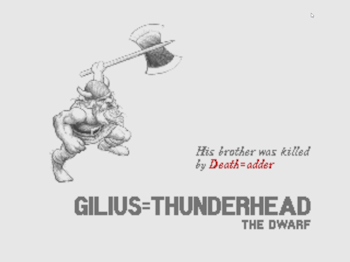
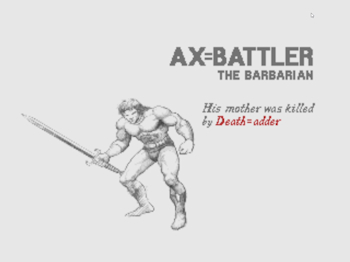
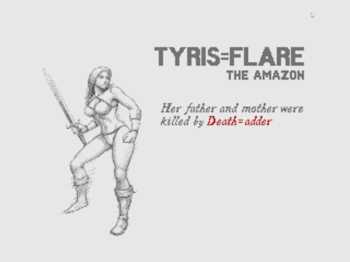
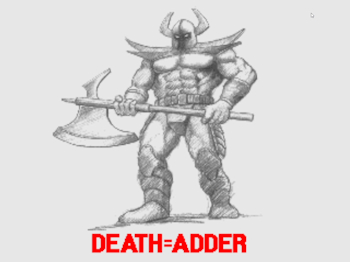
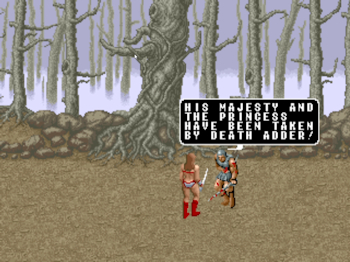
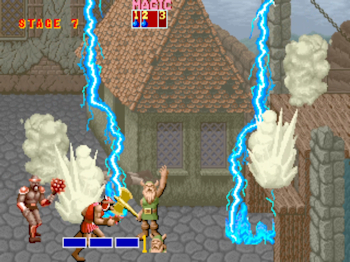
 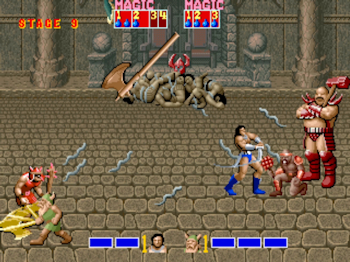
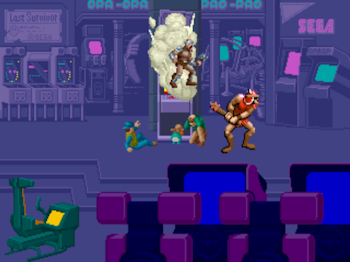


| ||||||||||||||||||||
|
| ||||||||||||||||||||
